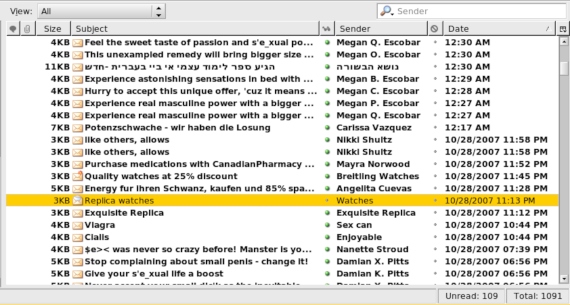In 1994, movies were watched on VHS tapes, CDs were the latest thing in musical media and mobile phones, the size of half a baguette, were still an eccentricity. The Internet already existed, but only certain institutions such as scientific centres had a somewhat decent connection; home users paid by the minute by connecting with their modems. Some of the Internet’s most essential services were taking their first baby steps, such as e-commerce, but so were some of its most insidious vices: on April 12 of that year, unwanted mass commercial advertising was officially instituted—in a word, spam.

When email was still far from being a means of mass communication, many of the users of that rudimentary Internet communicated through USENET, a discussion network divided into categories or newsgroups that is still active today, but which at that time was the place to be; in a way it was the first online social network.
Thus it was also the place where Laurence Canter and Martha Siegel decided to launch what would be the first commercial spam in the history of the Internet. This husband-and-wife team of lawyers was handling the Green Card Lottery application, the system put in place by the US government to increase the diversity of immigration into the country. In reality, all that was needed to register for the draw was to send a card with personal data to the address set up for this purpose, but Canter and Siegel decided to take advantage of the lack of knowledge of potential candidates to sell them a service for a high price.
To this end, they hired a computer scientist to send the announcement of their service to thousands of USENET newsgroups, where users encountered an unwanted intrusion in their conversations: “Green Card Lottery – Final One?” the message was titled. Lawyer and activist Ray Everett, who at the time worked as an information specialist for the US Immigration Lawyers Association, told Wired magazine in 1999 that the Canter and Siegel manoeuvre not only angered users, but also lawyers. And yet the campaign worked, so much so that it earned the pair $100,000. Both then dedicated themselves professionally to spam and published a successful book on how to make a fortune on the Internet.
The trail of massive electronic advertisement
Canter and Siegel’s advertising worked so well that they passed themselves off as the creators of spam, which is not true: theirs was the first commercial spam on the Internet, not the first spam. A few months earlier, in January 1994, a student had inserted into all USENET groups a message entitled “Global Alert for All: Jesus is Coming Soon”. The previous year, a bug in the software had unintentionally caused the mass posting of 200 messages on the USENET. But even before that, in 1988, the first chains of emails and the use of junk messages among online players had begun.

The trail continues to extend backwards, to what may be considered the first spam of the digital age. In 1978 there was not yet an Internet, but its precursor, ARPANET, the network instituted by the U.S. Department of Defence. On May 3 of that year, nearly 400 email users of this network —out of a total of some 2,600— received a message announcing the introduction of new computer models. The author of that first massive electronic advertisement was Gary Thuerk, who at the time worked for Digital Equipment Corporation. Thuerk considers himself the “father of spam,” as he says in his Twitter account.
Others agree. “Gary Thuerk was the first one that sent a spam message,” says Lon Safko, an innovator and consultant and author of several publications on spam, to OpenMind. “Canter and Siegel and the Green Card Lottery was just an example of someone who understood the power of spam and used it.”
Of course, in Thuerk’s day there was still no talk of spam, originally a famous brand of canned meat. In 1970, the BBC comedy show Monty Python’s Flying Circus broadcast a sketch in which a coffee waitress recited a menu teeming with Spam meat, a word that was also repeated over and over again in the final credits. In the 1980s, the joke inspired the use of the term to mean maliciously flooding online chat rooms. In 1993, as a result of the computer failure that poured hundreds of messages into USENET, it was the user Joel Furr who applied it to junk messages for the first time.
A still alive trend
Spam shone brightest in the first decade of this century; in 2008 it accounted for 85% of all email, despite the fact that four years earlier Microsoft co-founder Bill Gates had given it two years to live. “Back in the mid-2000s, a spammer named Ronnie Scelson sent out four billion spam mails every month,” Safko says. “He said that because sending email was free, even if only three to five people responded, he was still making a lot of money.”

Although the prevalence of spam has declined, experts say that it continues to be very much alive today, still accounting for 39% of all email, and this despite much effort to suppress it, both legal and technological. According to Safko, spam filters are improving, but so are spammers’ strategies for circumventing them. “It will remain a cold war,” he says, “but spam will always be with us.”
In fact, it may always have been so. Or it would have been had the media existed. On May 29, 1864, numerous prominent Londoners received a telegram in which one Gabriel announced his services as a dentist. Since this medium was used for urgent communications, several recipients were alarmed, which led to letters of indignation being sent to The Times. By then, telegraphy had enabled the sending of messages to multiple recipients, and when this technology arrived, the spirit of the spammer was already there.
Comments on this publication